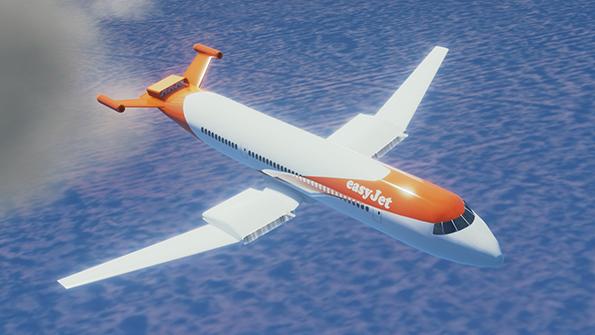
Electric-powered light aircraft are in production, prototype air taxis are flying, and now industry is looking at how the benefits of electrified aircraft propulsion could be brought to the commercial aviation market.
Spurred by concerns over carbon emissions from aviation, government money is beginning to flow in significant amounts into research to advance the state of the art in electric propulsion. And much of the work is focusing on developing technology for larger aircraft, up to the size of single-aisle airliners.
Current limitations on the energy density of batteries and the power density of motors and electronics have restricted the use of electric propulsion to lightweight, short-range two- and four-seat aircraft and the emerging category of electric vertical-takeoff-and-landing (eVTOL) air taxis. But already academia and industry, including several startups, are looking beyond these limits at the near-term development of commuter and regional aircraft with 9-19 seats and all-electric or hybrid-electric propulsion.
Electrifying the propulsion of the larger regional and commercial aircraft that generate the bulk of aviation’s carbon emissions, those with 70 or more seats and ranges measured in thousands of miles and not hundreds, is a far more daunting challenge. But government-funded research programs are getting underway in Europe and the U.S. that are targeting electric-propulsion technology for these larger aircraft.
In January, a consortium of 33 European aviation research and industry partners launched the Investigation and Maturation of Technologies for Hybrid Electric Propulsion (Imothep) program to assess its potential for reducing the emissions from commercial aviation and develop a technology road map for its development.
With €10.4 million ($11.3 million) in funding from the European Commission under its Horizon 2020 research program, Imothep will perform an in-depth investigation of hybrid-electric technologies, advanced aircraft configurations and innovative propulsion architectures that take advantage of synergies between propulsion and airframe.

Led by French aerospace research agency Onera, the program brings together European aircraft manufacturers Airbus and Leonardo; engine companies Safran, GE Avio, MTU, ITP and GKN; as well as aerospace research organizations CIRA (of Italy), DLR, AIT (of Austria), ILOT (of Poland), INCAS (of Romania) and NLR. Universities in France, Germany, Italy, Sweden and the UK are also involved, as is German aviation think tank Bauhaus Luftfahrt and intergovernmental air traffic organization Eurocontrol.
In the U.S., the Energy Department’s advanced research projects agency, ARPA-E, has announced plans to launch two research programs to develop propulsion technology for all-electric, 150-200-seat narrowbody airliners. The overall objective is the efficient conversion of the chemical energy in liquid fuel into electrical energy delivered to the aircraft’s propulsors.
With the stated goal of developing enabling technologies for Boeing 737-class aircraft with net-zero carbon emissions, the programs will focus on lightweight, ultra-efficient electric motors, drive electronics and thermal management systems as well as systems to convert carbon-neutral liquid fuels to electric power for propulsion.
The agency expects to make $35 million in funding available for the Ascend program (for Aviation-class Synergistically Cooled Electric Motors with Integrated Drives). Another $20 million is earmarked for the companion Reeach program (Range Extenders for Electric Aviation with Low Carbon and High Efficiency). Expected to run for up to 48 months, both efforts are planned to begin in November.
The programs are aimed at developing technologies for a propulsion architecture comprising an energy storage and power generation subsystem and an all-electric powertrain. Ascend is focused on the powertrain and Reeach on energy storage and power generation. A fault-resistant kilovolt distribution system is envisioned for transmitting power from the generation system to the motors driving the fans or propellers, but the electric bus and propulsors are outside of ARPA-E’s programs.
Ascend and Reeach would complement research into electrified aircraft propulsion for commercial aircraft already underway at NASA. Under the Hybrid Gas-Electric Propulsion (HGEP) project, the agency has funded development and testing of megawatt-class electric machines and power converters by Boeing, GE Aviation, two universities and NASA Glenn Research Center. HGEP included maturing concepts for hybrid-electric commercial aircraft. NASA is now planning to launch the Electrified Powertrain Flight Demonstration (EPFD) X-plane program in fiscal 2021.
In fiscal 2019, the agency conducted initial ground tests of a megawatt-scale powertrain in the NASA Electric Aircraft Testbed (NEAT) facility at Plum Brook Station in Ohio. The test used commercial off-the-shelf, non-flight-weight components and focused on communication and control. This year, NASA will test powertrain components at simulated flight altitude in the NEAT, looking at effects such as corona discharge. And in 2021, it plans to test a flight-weight megawatt-class inverter at 30,000 ft. in the NEAT.
Also in 2021, the agency plans to complete the critical design review on a project to demonstrate large-scale power extraction from both the high- and low-pressure spools of a turbofan. Power is extracted from only the low-pressure shaft of current engines, but future electrified aircraft will require more power-generation capacity. In 2016, GE demonstrated dual-spool power extraction using an F110 fighter engine, pulling 250 kW from the high-pressure shaft and 750 kW from the low-pressure shaft.
Pulling large amounts of power from a turbofan can affect its operability. But integrating a megawatt-scale motor/generator with the shaft of a gas turbine so that electric power can be extracted or stored energy inserted could allow the engine to be operated closer to its limits. That could reduce design margins, improve efficiency and potentially enable the use of smaller turbofans burning less fuel. This approach minimizes the battery weight required and could be a first step in hybridizing propulsion for single-aisle airliners.
NASA Glenn’s NEAT is the first electric-propulsion test facility of its kind, but other organizations are looking at the infrastructure that will be required to develop, test, certify and operate electric aircraft. Under the EU-funded Green Flyway project, Norway and Sweden are creating a test area providing an environment for testing electric aircraft as well as small and medium-size unmanned aircraft.
The test area provides hangar space, a large amount of little-used airspace, cross-border flying between Ale Ostersund Airport in Sweden and Roros Airport in Norway, and point-to-point routes—Sweden’s Harjedalen Sveg and Ornskoldsvik Airports are also part of the project. As a first step toward enabling all 10 of the country’s airports to handle electric aircraft, Swedish airport operator Swedavia is equipping Ale Ostersund as a test site, with battery charging infrastructure and the electrical power supply needed.
There are also several government-supported programs underway to electrify existing aircraft as testbeds and potential commercial ventures. In the UK, Project Fresson led by Cranfield Aerospace Solutions will modify the 11-seat Britten-Norman Islander with hybrid-electric propulsion for short-range and island-hopping routes. The UK government is providing half the £18 million ($23 million) cost of the project. First flight is planned in 2022.
With support from the Bavarian government, German aerospace center DLR is to modify a Dornier 228 into an electrified aircraft propulsion demonstrator. The first fully electric flight is planned for this year and the first hybrid-electric flight for 2021. The regional government of Berlin/Brandenburg plans to fund another electric-propulsion project, using a purpose-designed technology demonstrator, the APUS i-6. The French government, meanwhile, is supporting a project by Airbus, Daher and Safran to convert a TBM900 to distributed hybrid-electric propulsion.
With the continued high level of interest in electrified aircraft propulsion as a way to reduce aviation emissions despite the many challenges to scaling up the technology, the growing amount of government support is likely to propel progress.
